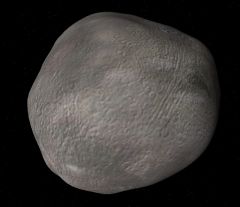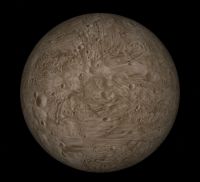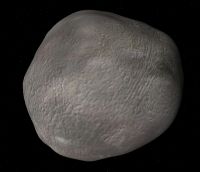Difference between revisions of "Trinculo"
(Arvil moved page User:Arvil/Sandbox02 to S/2005 S49: Move to article page.) Tag: New redirect |
(Added content.) |
||
| (10 intermediate revisions by the same user not shown) | |||
| Line 1: | Line 1: | ||
| − | + | {| cellpadding="2" cellspacing="0" style="margin:25px 0 0 10px; border:3px solid lightsteelblue;width:250px; font-size:90%; font-family:'Arial','Helvetica'; float: right; clear: right;"Template in Orbiter" | |
| + | !bgcolor="lightsteelblue" colspan="2" align="center" |Trinculo | ||
| + | |- | ||
| + | |colspan="2" align="center"|[[Image:Trinculo-UranusMoonszip-Orbiter2003P2.jpg|240px]] | ||
| + | |- | ||
| + | |colspan="2" align="center"|<center>'''Trinculo from ''UranusMoons.zip'' in Orbiter 2003P2'''</center> | ||
| + | |- | ||
| + | !bgcolor="lightsteelblue" colspan="2"|Designation | ||
| + | |- | ||
| + | |Name||align="right"|Trinculo | ||
| + | |- | ||
| + | |width="30%"|Reference body||align="right" width="30%"|Uranus | ||
| + | |- | ||
| + | !bgcolor="lightsteelblue" colspan="2"|Planetary mean orbits | ||
| + | |- | ||
| + | |width="30%"|Epoch||align="right" width="50%"|2006 | ||
| + | |- | ||
| + | |width="30%"|Semimajor axis (a)||align="right" width="50%"|8496228897.89111 m | ||
| + | |- | ||
| + | |width="30%"|Eccentricity (e)||align="right" width="30%"|0.218505547246334 | ||
| + | |- | ||
| + | |width="30%"|Inclination (i)||align="right" width="30%"|166.2593647° <br> (2.90177332700291 radian) | ||
| + | |- | ||
| + | |width="30%"|Longitude of the ascending node (LAN, ☊)||align="right" width="30%"|199.1043345° <br> (3.47502619249875 radian) | ||
| + | |- | ||
| + | |width="30%"|Longitude of periapsis (ϖ)||align="right" width="30%"|360.0224313° <br> (6.28357680641652 radian) | ||
| + | |- | ||
| + | |width="30%"|Mean longitude (L)||align="right" width="30%"|516.776573° <br> (9.01945269651501 radian) | ||
| + | |- | ||
| + | !bgcolor="lightsteelblue" colspan="2"|Selected physical parameters | ||
| + | |- | ||
| + | |width="30%"|Mean radius||align="right" width="30%"|5000 m | ||
| + | |- | ||
| + | |width="30%"|Mass||align="right" width="30%"|1.3×10<sup>15</sup> kg | ||
| + | |- | ||
| + | |width="30%"|SidRotPeriod||align="right" width="30%"|65499840 (758.1 days) | ||
| + | |- | ||
| + | |width="30%"|SidRotOffset||align="right" width="30%"|0 | ||
| + | |- | ||
| + | |width="30%"|Obliquity||align="right" width="30%"|1.4346 | ||
| + | |- | ||
| + | |width="30%"|LAN||align="right" width="30%"|2.9255 | ||
| + | |- | ||
| + | |width="30%"|Note||align="right" width="30%"|*Elements given are from S2000-U1.cfg (UranusMoons.zip) | ||
| + | |} | ||
| + | |||
| + | '''Trinculo (Uranus XXI, S/2001 U 1)''' a retrograde irregular [[Natural satellites|moons]] of [[Uranus]]. It was discovered by [[w:Matthew J. Holman|Matthew J Holman]] et al on 13 August 2001. It is named for a drunken jester [[w:William Shakespeare|William Shakespeare's]] [[w:The Tempest|The Tempest]]. | ||
| + | |||
| + | == Trinculo in Orbiter == | ||
| + | First, it must be noted that although the temporary designation of Trinculo was S/2001 U 1, Rolf released it as S2000-U1 in uranus-neptune_ii.zip in March 2003. Note that Trinculo is provided by the add-on as ''S2000-U1''. To simulate it as ''Trinculo'', the following changes need to be made. | ||
| + | |||
| + | *File:S2000_U1.cfg: | ||
| + | **change the filename to Trinculo.cfg | ||
| + | **change the name in the comment line in the top line to ''Trinculo (S2000-U1, Saturn)'' | ||
| + | **line 3, change ''NAME ='' to Trinculo | ||
| + | **Last line, change the name of ''Base1 ='' to Trinculo | ||
| + | *File:U1-Station.cfg | ||
| + | **change the filename to Trinculo-station.cfg | ||
| + | **Line 3, change the name to Trinculo-Station | ||
| + | *File:Uranus_S2000U1.scn | ||
| + | **change the filename to Uranus_Trinculo.scn | ||
| + | **Line 2, change ''U1 Station'' to ''Trinculo Station'' | ||
| + | **Find the GL-01 ship, change STATUS ''Landed S2000-U1'' to ''Landed Trinculo'' | ||
| + | **Change BASE ''U1-Station:1'' to ''Trinculo-Station:1'' | ||
| + | |||
| + | *File:S2000-U1.tex, change filename to Trinculo.tex | ||
| + | |||
| + | *File:S2000-U1M.BMP, change filename to TrinculoM.BMP | ||
| + | |||
| + | {|class="wikitable sortable” style="text-align: center" | ||
| + | |- | ||
| + | |colspan="8"|<center>'''Orbiter versions and add-ons which include Trinculo'''</center> | ||
| + | |- | ||
| + | !Add-on!!Source!!Version!!Author!!Type!!Release Date!!Compatibility!!Wiki article | ||
| + | |- | ||
| + | |[https://www.orbiter-forum.com/resources/uranus-minor-moons.1765/ Uranus Minor Moons]||O-F Resources||2004-12-14||Nighthawke||Scenery||14 December 2004|||| | ||
| + | |- | ||
| + | |[https://library.avsim.net/esearch.php?DLID=&Name=&FileName=uranus-neptune_ii.zip&Author=&CatID=root Uranus-Neptune II]||AVSIM||||Rolf B Keibel||Scenery||6 March 2003|||| | ||
| + | |} | ||
| + | |||
| + | == See also == | ||
| + | [[w:Trinculo (moon)|Trinculo]] at [[w:Wikipedia|Wikipedia]] | ||
| + | |||
| + | == Gallery == | ||
| + | <gallery widths="200" heights="200"> | ||
| + | Trinculo-uranusneptuneiizip.jpg|<center>Trinculo from ''uranus-neptune_ii.zip'' in Orbiter 2002P3</center> | ||
| + | Trinculo-UranusMoonszip-Orbiter2003P2.jpg|<center>Trinculo from ''UranusMoons.zip'' in Orbiter 2003P2 | ||
| + | Animation of Sycorax orbit around Uranus.gif|<center>Trinculo's orbit is shown in green in this animation.</center> | ||
| + | </gallery> | ||
| + | |||
| + | {{UranusSat}} | ||
| + | {{SolarSystem}} | ||
| + | |||
| + | [[Category:Articles]] | ||
| + | [[Category:Celestial bodies]] | ||
| + | [[Category:Solar System]] | ||
| + | [[Category:Natural satellites]] | ||
| + | [[Category:Satellites of Uranus]] | ||
| + | |||
| + | {{Nsat-Stub}} | ||
Latest revision as of 03:48, 15 September 2024
Trinculo (Uranus XXI, S/2001 U 1) a retrograde irregular moons of Uranus. It was discovered by Matthew J Holman et al on 13 August 2001. It is named for a drunken jester William Shakespeare's The Tempest.
Trinculo in Orbiter[edit]
First, it must be noted that although the temporary designation of Trinculo was S/2001 U 1, Rolf released it as S2000-U1 in uranus-neptune_ii.zip in March 2003. Note that Trinculo is provided by the add-on as S2000-U1. To simulate it as Trinculo, the following changes need to be made.
- File:S2000_U1.cfg:
- change the filename to Trinculo.cfg
- change the name in the comment line in the top line to Trinculo (S2000-U1, Saturn)
- line 3, change NAME = to Trinculo
- Last line, change the name of Base1 = to Trinculo
- File:U1-Station.cfg
- change the filename to Trinculo-station.cfg
- Line 3, change the name to Trinculo-Station
- File:Uranus_S2000U1.scn
- change the filename to Uranus_Trinculo.scn
- Line 2, change U1 Station to Trinculo Station
- Find the GL-01 ship, change STATUS Landed S2000-U1 to Landed Trinculo
- Change BASE U1-Station:1 to Trinculo-Station:1
- File:S2000-U1.tex, change filename to Trinculo.tex
- File:S2000-U1M.BMP, change filename to TrinculoM.BMP
| Add-on | Source | Version | Author | Type | Release Date | Compatibility | Wiki article |
|---|---|---|---|---|---|---|---|
| Uranus Minor Moons | O-F Resources | 2004-12-14 | Nighthawke | Scenery | 14 December 2004 | ||
| Uranus-Neptune II | AVSIM | Rolf B Keibel | Scenery | 6 March 2003 | |||
See also[edit]
Gallery[edit]
| Uranus's natural satellites |
|---|
|
Named Satellites: Ariel | Belinda | Bianca | Caliban | Cordelia | Cressida | Cupid | Desdemona | Ferdinand | Francisco | Juliet | Mab | Margaret | Miranda | Oberon | Ophelia | Perdita | Portia | Prospero | Puck | Rosalind | Setebos | Stephano | Sycorax | Titania | Trinculo | Umbriel Numbered Satellites:| S/2023 U1 |
| See also: Pronunciation key | rings of Uranus |
| edit The Solar System | |
|---|---|
| Central star |
Sun (Sol) |
| Planets |
Mercury - Venus - Earth - Mars - Jupiter - Saturn - Uranus - Neptune |
| Natural satellites |
Moon - Phobos - Deimos - Io - Europa - Ganymede - Titan - more... |
| Add-ons |
Planets - Dwarf Planets - Small objects - Natural satellites - Alternative star systems |
 | This natural satellite related article is a stub. You can help Orbiterwiki by expanding it.
|



